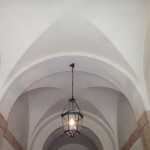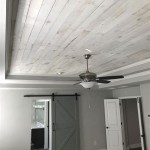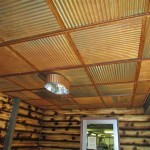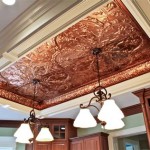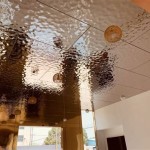Can You Put Wallpaper On Drop Ceiling Tiles In Bathroom? Exploring the Feasibility and Challenges
The question of whether wallpaper can be applied to drop ceiling tiles in a bathroom is a complex one that involves considering several factors. Bathrooms, by their nature, are high-humidity environments, which presents unique challenges for any surface covering, including wallpaper. While the concept of adding wallpaper to drop ceiling tiles to enhance aesthetics or conceal imperfections might seem appealing, a thorough understanding of the potential issues and necessary precautions is crucial before proceeding.
Drop ceiling tiles are commonly made of mineral fiber, fiberglass, or other lightweight materials designed for sound absorption and ease of installation. These materials are often porous and not inherently moisture-resistant. Wallpaper, on the other hand, is a decorative material applied to walls and ceilings using adhesive. The compatibility of these two materials in a humid environment like a bathroom is the primary concern. This article aims to explore the feasibility of applying wallpaper to drop ceiling tiles in a bathroom, addressing the challenges, potential solutions, and alternative options.
Understanding the Challenges of Wallpaper in Bathrooms
Bathrooms pose a particular challenge for wallpaper due to the high levels of humidity and moisture. Steam from showers and baths can penetrate the wallpaper and the adhesive, leading to several potential problems. These problems can range from minor aesthetic issues to more significant structural damage.
Firstly, moisture can weaken the adhesive bond between the wallpaper and the ceiling tile. This can cause the wallpaper to peel, bubble, or sag, compromising the aesthetic appeal and potentially requiring replacement or repair. Wallpaper adhesives are typically formulated for use on solid, relatively non-porous surfaces. The porous nature of many drop ceiling tiles means they can absorb moisture, preventing the adhesive from forming a strong, lasting bond. This is further exacerbated by the constant fluctuation in humidity levels within a bathroom.
Secondly, moisture can promote the growth of mold and mildew behind the wallpaper. The damp, dark environment created between the wallpaper and the ceiling tile provides an ideal breeding ground for these organisms. Mold and mildew not only pose a health risk but can also damage the ceiling tiles and the wallpaper itself, leading to discoloration, staining, and eventual deterioration. The presence of mold can necessitate costly remediation and replacement of the affected materials.
Thirdly, the type of wallpaper itself can influence its suitability for bathroom use. Traditional wallpaper, often made of paper, is highly susceptible to moisture damage. Vinyl wallpaper, which is more water-resistant, is generally considered a better option for bathrooms. However, even vinyl wallpaper is not entirely impervious to moisture and can still experience issues related to humidity and condensation. The seams between wallpaper strips are particularly vulnerable to moisture penetration, even with vinyl options.
Factors to Consider Before Applying Wallpaper to Drop Ceiling Tiles
Before deciding to apply wallpaper to drop ceiling tiles in a bathroom, several key factors must be carefully considered. These factors relate to the type of ceiling tile, the type of wallpaper, the level of ventilation in the bathroom, and the preparation methods employed.
The type of ceiling tile is paramount. Mineral fiber tiles, being highly porous, are generally not suitable for wallpaper application in bathrooms without significant pre-treatment. Fiberglass tiles offer slightly better moisture resistance but still require careful consideration. If the tiles have a textured surface, it may be necessary to smooth them out before applying wallpaper to ensure a proper bond. This can involve using a leveling compound and sanding the surface to create a smooth, even substrate.
The choice of wallpaper is equally important. Vinyl wallpaper, particularly scrubbable vinyl wallpaper, is the preferred option due to its water resistance. However, even with vinyl wallpaper, it is essential to ensure that the seams are properly sealed to prevent moisture penetration. Consider using a specialized seam sealant designed for wet environments. Furthermore, some wallpapers are specifically designed for bathroom use and incorporate antimicrobial agents to inhibit mold and mildew growth.
Bathroom ventilation plays a critical role in mitigating moisture-related problems. A well-functioning exhaust fan that effectively removes steam and humidity is essential. The fan should be used during and after showers and baths to minimize moisture buildup. Regular cleaning and maintenance of the exhaust fan are also necessary to ensure its optimal performance. Inadequate ventilation significantly increases the risk of wallpaper failure and mold growth.
Proper surface preparation is crucial for ensuring a good bond between the wallpaper and the ceiling tile. The tiles should be thoroughly cleaned to remove any dirt, dust, or grease. A primer specifically designed for porous surfaces should be applied to seal the tiles and create a more suitable substrate for the wallpaper adhesive. This primer helps to prevent the adhesive from being absorbed into the tile, ensuring a stronger bond. It is also crucial to allow the primer to dry completely before applying the wallpaper.
Alternative Options and Precautions
Given the inherent challenges of applying wallpaper to drop ceiling tiles in bathrooms, it is prudent to explore alternative options that offer similar aesthetic benefits with reduced risks. These alternatives include specialized ceiling tiles, moisture-resistant paints, and decorative panels.
Specialized ceiling tiles designed for bathroom use are available from various manufacturers. These tiles are typically made of moisture-resistant materials and may have antimicrobial properties to inhibit mold and mildew growth. They are available in a range of styles and finishes, offering a more durable and practical alternative to wallpaper. While potentially more expensive upfront, their longevity and resistance to moisture damage can make them a more cost-effective solution in the long run.
Moisture-resistant paints specifically formulated for bathrooms are another viable option. These paints contain additives that prevent mold and mildew growth and offer a durable, washable finish. They are available in a wide range of colors and can be applied directly to the ceiling tiles after proper preparation. While paint may not offer the same level of visual interest as wallpaper, it provides a practical and durable solution for bathrooms.
Decorative panels, such as PVC panels or textured panels, can also be used to enhance the aesthetic appeal of a drop ceiling in a bathroom. These panels are typically moisture-resistant and easy to install, providing a durable and attractive alternative to wallpaper. They are available in various styles and finishes, allowing for customization to match the bathroom's decor.
If wallpaper is the preferred option despite the challenges, several precautions should be taken to minimize the risk of failure. Firstly, ensure that the bathroom is properly ventilated. Secondly, use only high-quality, scrubbable vinyl wallpaper specifically designed for bathroom use. Thirdly, apply a primer specifically designed for porous surfaces to seal the ceiling tiles. Fourthly, use a strong, mold-resistant wallpaper adhesive. Fifthly, carefully seal all seams with a seam sealant designed for wet environments. Finally, regularly inspect the wallpaper for signs of peeling, bubbling, or mold growth and address any issues promptly.
In conclusion, while it is technically possible to apply wallpaper to drop ceiling tiles in a bathroom, it is a challenging undertaking that requires careful consideration of various factors. The high humidity and moisture levels in bathrooms pose significant risks to wallpaper, potentially leading to peeling, bubbling, mold growth, and eventual failure. While vinyl wallpaper and proper preparation can mitigate some of these risks, alternative options such as specialized ceiling tiles, moisture-resistant paints, and decorative panels offer more durable and practical solutions. A thorough assessment of the bathroom's environment, the type of ceiling tile, and the available resources is crucial before making a decision.

How To Cover Drop Ceiling Tiles Decorative Inc

Wallpaper Bathroom Ceiling Tiktok

Elevate Your Style With These Bathroom Ceiling Ideas

How To Make A Drop Ceiling Look Better

Modern Drop Ceiling Ideas To Love Craving Some Creativity

Beadboard Ceiling Tiles B4 And Afters A Drop Alternative

Beadboard Ceiling Tiles B4 And Afters A Drop Alternative

Creative Bathroom Ceiling Ideas For Your Home Renovation

Creative Drop Ceiling Ideas B4 And Afters

Drop Ceiling What S Hot By Jigsaw Design Group
Related Posts


